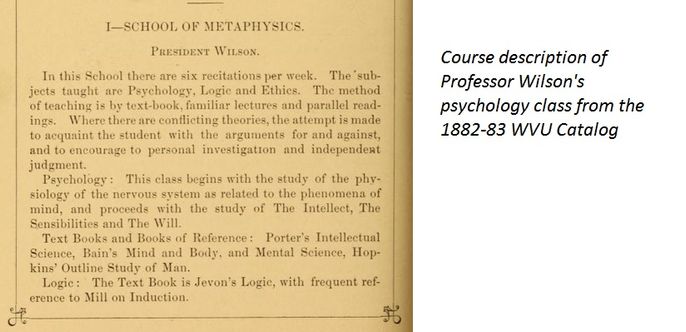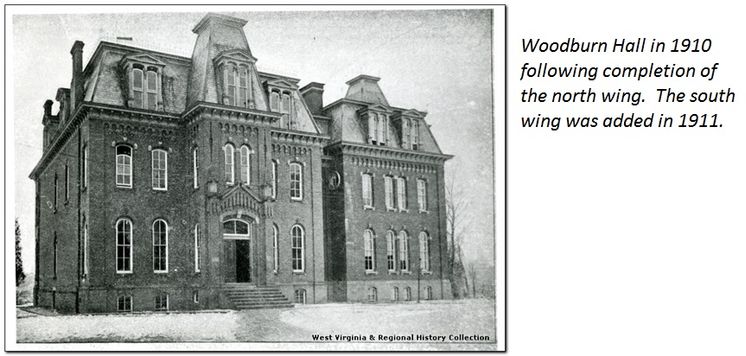The science of psychology was founded in Leipzig, Germany in the laboratory of Wilhelm
Wundt in 1879, so this scientific area of exploration did not exist when WVU was
formed. Content closest to psychological inquiry was first taught by President Martin
and other professors of mental and moral sciences in the Classical Department who were each trained in the ministerial
tradition. However, as the new science of psychology made its way across the Atlantic
Ocean, it was not long before a class in psychology was offered at WVU. William A.
Wilson, Professor of Metaphysics, taught the first psychology class at WVU in 1882
and it was taught regularly thereafter by professors in the School of Metaphysics.

Although lacking formal training in psychology, Powell B. Reynolds, another professor in this department who served as acting President of WVU in the 1890s, was the first faculty member to be named as Professor of Psychology at West Virginia University in 1895.
WVU first enrolled women in 1889 and class sizes more than doubled over the next decade. Graduating at the top of her class, Harriot Lyon was the first woman to obtain a degree from WVU in 1891. Academic departments were re-organized to accommodate this growth and the College of Arts and Sciences was formed. The School of Metaphysics, renamed the Department of Philosophy, was housed in the new College, and Professor Reynolds continued instructing courses in physiological and comparative psychology in this newly re-organized unit.
Recognizing the opportunities to grow enrollment beyond the traditional fall and spring semesters, WVU’s new president, Jerome Raymond, launched a plan to offer courses during summer sessions in 1898. This proved to be quite popular among students attending other universities that did not hold summer sessions, but also as an avenue for inviting recognized academics from around the country to serve as instructors for these offerings. These efforts enabled WVU students to take psychology courses from Daniel Edward Phillips, PhD, (Professor of Psychology at the University of Denver), Edward Wheeler Scripture, PhD (Professor of Psychology at Yale University), and Margaret Keiver Smith, PhD (Professor of Psychology and Geography at the State Normal School in Paltz, New York).

After serving a decade as President of Denison University in Ohio, alumnus Daniel Boardman Purinton returned to WVU to become its next president in 1901. As Professor of Philosophy, he assumed instruction of the annual course in psychology. A second course, entitled “Applications of Psychology for Learning and Teaching” was taught by Professor Jasper Diehl, PhD, in the Department of Education.
Among the students who attended West Virginia University around the turn of the century were Elizabeth Mattingly Stalnaker and Karl Lashley. Traveling over the mountains from the eastern panhandle to attend WVU, Ms. Stalnaker arrived in 1898 to study fine arts and languages, earning a degree in 1902 with majors in German and French. Although she held teaching positions at Shepherd College, Fairmont State Normal School (now Fairmont State University), and Marshall College (now University) following receipt of her degree, she went on to earn a master’s degree at Columbia University and a PhD in psychology at Johns Hopkins University in 1923.
 Young Karl Spencer Lashley arrived in Morgantown in 1907 from his home in Davis,
WV. He spent most of his academic training in Woodburn Hall in the Department of
Zoology, serving as a laboratory assistant for Professor Albert Reese, earning 25
cents an hour, before attaining his bachelor’s degree in 1910. He pursued graduate
study at the University of Pittsburgh, earning his master’s degree in 1911, and at
Johns Hopkins University, earning his doctorate in 1914. Although his major program
of study was zoology, he engaged in a minor area of study with John B. Watson at
Hopkins, who piqued Lashley’s interest in psychology. Lashley went on to hold faculty
appointments in psychology at both the University of Minnesota and the University
of Chicago prior to joining the faculty at Harvard University in 1935, where he spent
the remainder of his academic career. Professor Lashley is highly recognized for
his empirical work on learning and memory and served as President of the American
Psychological Association in 1929. Interestingly, he made lifelong contributions
to psychology and was instrumental in launching the field now recognized as behavioral
neuroscience without earning a single degree in psychology!
Young Karl Spencer Lashley arrived in Morgantown in 1907 from his home in Davis,
WV. He spent most of his academic training in Woodburn Hall in the Department of
Zoology, serving as a laboratory assistant for Professor Albert Reese, earning 25
cents an hour, before attaining his bachelor’s degree in 1910. He pursued graduate
study at the University of Pittsburgh, earning his master’s degree in 1911, and at
Johns Hopkins University, earning his doctorate in 1914. Although his major program
of study was zoology, he engaged in a minor area of study with John B. Watson at
Hopkins, who piqued Lashley’s interest in psychology. Lashley went on to hold faculty
appointments in psychology at both the University of Minnesota and the University
of Chicago prior to joining the faculty at Harvard University in 1935, where he spent
the remainder of his academic career. Professor Lashley is highly recognized for
his empirical work on learning and memory and served as President of the American
Psychological Association in 1929. Interestingly, he made lifelong contributions
to psychology and was instrumental in launching the field now recognized as behavioral
neuroscience without earning a single degree in psychology!

The first psychology laboratory at WVU was opened in 1915 in Woodburn Hall, jointly shared by the Departments of Education and Philosophy due to the overlapping faculty instructors in these two departments. The laboratory contained equipment for mental testing and conducting psychological experiments and enabled Professor Diehl to offer a course in Mental Tests and Measurements. Instrumentation included the Binet-Simon scale along with other devices used for measuring sensory systems, like an audiometer and tuning forks to test hearing, a color mixer and various lenses to test vision, and mirror tracing apparatuses, tapping boards, and dynamometers to test sensory-motor responses.
< History HOME NEXT History Page >
Although lacking formal training in psychology, Powell B. Reynolds, another professor in this department who served as acting President of WVU in the 1890s, was the first faculty member to be named as Professor of Psychology at West Virginia University in 1895.
WVU first enrolled women in 1889 and class sizes more than doubled over the next decade. Graduating at the top of her class, Harriot Lyon was the first woman to obtain a degree from WVU in 1891. Academic departments were re-organized to accommodate this growth and the College of Arts and Sciences was formed. The School of Metaphysics, renamed the Department of Philosophy, was housed in the new College, and Professor Reynolds continued instructing courses in physiological and comparative psychology in this newly re-organized unit.
Recognizing the opportunities to grow enrollment beyond the traditional fall and spring semesters, WVU’s new president, Jerome Raymond, launched a plan to offer courses during summer sessions in 1898. This proved to be quite popular among students attending other universities that did not hold summer sessions, but also as an avenue for inviting recognized academics from around the country to serve as instructors for these offerings. These efforts enabled WVU students to take psychology courses from Daniel Edward Phillips, PhD, (Professor of Psychology at the University of Denver), Edward Wheeler Scripture, PhD (Professor of Psychology at Yale University), and Margaret Keiver Smith, PhD (Professor of Psychology and Geography at the State Normal School in Paltz, New York).
After serving a decade as President of Denison University in Ohio, alumnus Daniel Boardman Purinton returned to WVU to become its next president in 1901. As Professor of Philosophy, he assumed instruction of the annual course in psychology. A second course, entitled “Applications of Psychology for Learning and Teaching” was taught by Professor Jasper Diehl, PhD, in the Department of Education.
Among the students who attended West Virginia University around the turn of the century were Elizabeth Mattingly Stalnaker and Karl Lashley. Traveling over the mountains from the eastern panhandle to attend WVU, Ms. Stalnaker arrived in 1898 to study fine arts and languages, earning a degree in 1902 with majors in German and French. Although she held teaching positions at Shepherd College, Fairmont State Normal School (now Fairmont State University), and Marshall College (now University) following receipt of her degree, she went on to earn a master’s degree at Columbia University and a PhD in psychology at Johns Hopkins University in 1923.
The first psychology laboratory at WVU was opened in 1915 in Woodburn Hall, jointly shared by the Departments of Education and Philosophy due to the overlapping faculty instructors in these two departments. The laboratory contained equipment for mental testing and conducting psychological experiments and enabled Professor Diehl to offer a course in Mental Tests and Measurements. Instrumentation included the Binet-Simon scale along with other devices used for measuring sensory systems, like an audiometer and tuning forks to test hearing, a color mixer and various lenses to test vision, and mirror tracing apparatuses, tapping boards, and dynamometers to test sensory-motor responses.
< History HOME NEXT History Page >